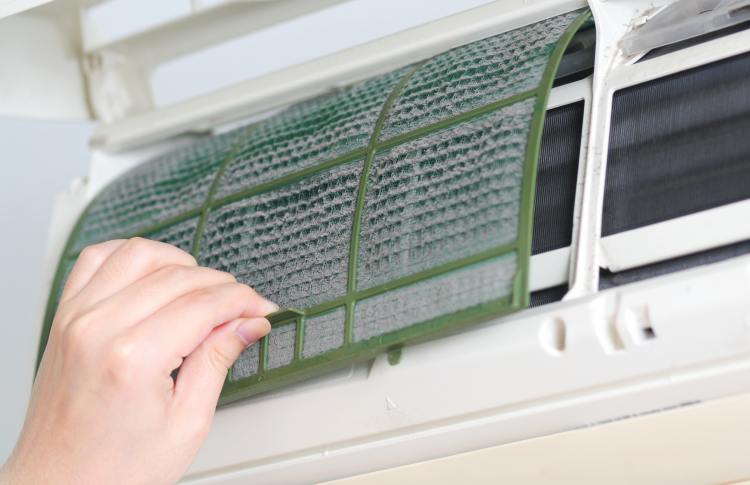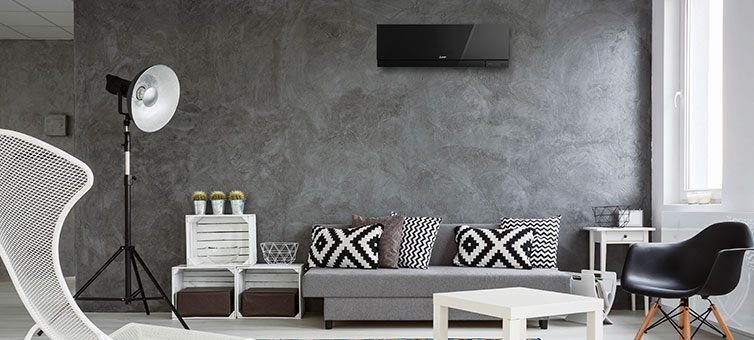There are different types of air conditioning units, and the split system air conditioning is the most popular one among residences and offices across Australia. There are several options for split system a/c and these include Wall Mounted Air Conditioning, Single Room Unit, Multi-head System, and In-ceiling Cassette.
What is Split System Air Conditioning?
As the name suggests, the split system HVAC is divided into two units: one inside the house or building, and one on the outside. These units are linked together with copper tubing.
The indoor unit of the split system is composed of a fan, filters, heat exchange coil, air handlers and signal receiver (for units controlled with a remote). This is the unit that brings in the conditioned air into the rooms or space. Depending on the type of split system, the indoor unit also includes either a fan coil or a gas furnace.
On the other hand, the outdoor unit of the split system houses a circuit board, propeller fan, heat exchange coil and compressor. This unit is responsible for pumping refrigerant in and out from the indoor unit. For this reason, the outdoor unit is often referred to as the “heat exchanger” or the “condenser.”
Depending on the kind of split system, the outdoor unit includes either a heat pump or air conditioner. A heat pump electronically extracts heat from the air outside and brings it into the indoor unit where the fan circulates warm air through the air handler. On the other hand, air cooling split-type systems have a compressor and condenser in their outside units while filters, air handler and evaporator comprise the indoor unit.
The split system unit may also be a reverse-cycle air conditioner, which means it can both cool and heat an area depending on the season. In some cases, a furnace is used as part of the indoor unit where air is heated and then distributed to the rooms. The furnaces need to burn propane, gas and other fuel to be operational. In addition, fan coils are also part of the indoor unit that blows or moves the heated or cooled air which passes around the coils to be circulated to the rooms.
Sometimes, there are multiple indoor units connected to a single outdoor unit. This is called the multi-split air conditioning system and is ideal to cool or heat multiple rooms at a time. It is also the perfect system to evenly provide conditioned air into one large room by using at least two units in the area.
The split system is one of the most popular types of air conditioning in many homes because it is known for its energy efficiency as well as silent operations. Another reason why split system is a popular choice is that it is easy and quick to install since there is no need to plan and install the ducts, unlike the central air conditioning. The ductless system generally uses small air handlers that blow warm or cool air into specific areas.
However, some split-system air conditioning units, such as the so-called mini-splits, can also be ducted wherein new or existing ductworks can be used to distribute cool or warm air from the fan coil, heat pump, gas burner or air conditioner. This is perfect for those who don’t want to use another central heating/cooling system to replace the old one but also dislike the look of a bulky ceiling recessed or wall-mounted air conditioning ruining their interior design.
There are different types of air conditioning units, and the split system air conditioning is the most popular one among residences and offices across Australia. There are several options for split system a/c and these include: Wall Mounted Air Conditioning, Single Room Unit, Multi-head System and In-ceiling Cassette.

How does a split system work?
To understand how a split system works, we will first have to talk about the refrigerant and its circulation within the air conditioning unit. This substance, in its liquid form, will flow inside the indoor unit where it will absorb the heat from inside the house or rooms. It will also pass through the evaporator where it will turn back into gas while it rapidly expands and causes the temperature to significantly drop.
The gas will then flow through the copper tubing and into the outdoor unit. In here, the heat will be dispersed into the atmosphere. The refrigerant gas will also pumped into the condenser where it will cool down and will turn into liquid once again. The refrigerant gas will then be pumped back into the evaporator, and the cycle will be repeated.
In cooling mode, the hot air inside the house or rooms will be extracted into the air conditioning unit where it will be cooled while passing through the evaporator coils. Remember that it’s in the evaporator where the refrigerant causes the temperature to drop and ultimately cooling the air that passes through the coils. The cool air is then pushed out from the unit to the house or rooms with a fan or blower. This cycle is repeated several times until the desired temperature for the room as set by the air conditioning unit’s thermostat is achieved. The air conditioning unit will then automatically shut down.
In heating mode, such as in the case of split system units with reverse cycle, atmospheric air is extracted into the outdoor unit where it is heated up before it is distributed into the room. The cycle of the refrigerant gas inside the unit is also reversed. The gas will flow through the unit’s chamber first before it is pumped into the condenser where it is compressed and starts to heat up. The temperature starts to rise and the air passing through the condenser coil is heated. The air with the desired temperature is then pushed out of the unit to warm up the house or room.
Does split system air conditioning bring in fresh air?
Unfortunately, a split system air conditioning does not bring fresh air into your home or rooms. This is a common misunderstanding regarding the split system and it’s probably because there are mechanisms inside the building as well as outside. And thus, people will perceive it to be getting fresh air from outside and blow them inside.
But now that we explained how a split system works with its indoor and outdoor units, we can definitely see that fresh air will not be moving from the outdoor to the inside of the house or building through the cooling/heating unit. In short, the split system air conditioning is simply not designed to do that.
To clarify, the indoor unit of an air conditioning sucks in warm air or heat from the room, cools it down around the evaporator coils, and then blows it out back to the room as cool air. In essence, the air is recycled in and out of the room, and the evaporator coils are responsible for cooling the air.
The recycled air, unfortunately, is one of the reasons why everyone starts to get sick when one person is sick inside one room. Have you noticed that if a family member is having the flu, the other members will soon be getting sick, too? It’s because everyone in the house is breathing the same recycled air which is full of bacteria, viruses and other contaminants.
Fortunately, to prevent microbes, allergens, pollutants and other harmful elements from contaminating the air we breathe indoors, we must use air filters. Air conditioners are basically equipped with filters to ensure that you’re breathing fresh air inside your house by trapping the pollutants and microorganisms that may be flowing with the recycled air. To effectively trap microbes and pollutants that are 0.3 microns in size or smaller, a High-Efficiency Particulate Air (HEPA) filter must be used. Their fine mesh can trap a wide range of ultrafine particles and even tobacco smoke. Most importantly, the filters must be cleaned or replaced regularly depending on how often the air conditioning is used and the conditions of the environment for which the unit is installed.

How often should I refill gas on split system?
The quick answer: Gas refill, sometimes called A/C regas, is only done when there is a refrigerant leak caused by damage to the tubing or simply due to natural wear and tear. Sometimes, the leak can also be due to a poor service or workmanship on the unit in the past.
First of all, it should be clarified that refilling the refrigerant gas on the split system is not about the depletion of gas due to constant use. When the air conditioning unit is brand new, it has enough refrigerant gas inside it to last the expected lifespan of the split system unit.
Furthermore, refilling gas is simply not pouring refrigerant to the existing supply in the unit. The existing refrigerant must be fully removed (also referred to as “evacuating the system) before you can add a new supply. In short, the old supply must be replaced entirely.
Among the signs of a refrigerant leak are:
- A deficit in the cooling efficiency despite setting the thermostat at the right temperature;
- Warm air is coming out of the unit and into the room when you expected it to be cool;
- The formation of ice on the evaporator coil (the ice acts as an insulation which prevents the refrigerant from cooling the air); and
- Bubbling or hissing sounds heard from the external copper tubing.
While these signs may be easy to spot, there are also other causes of refrigerant leak that may be hard to investigate especially that the components inside the outdoor unit are hard to reach. Furthermore, you will never know when a refrigerant leak can happen. And thus, hiring an experienced air conditioning technician for maintenance and gas refill services will ensure that your unit will always be in good working condition and any potential problem will be addressed immediately before it becomes worse.
For premium quality Split System Air Conditioning services in Perth, get in touch with us here at Complete Air Systems. We have over 30 years of experience in servicing both residential and commercial air conditioning. We also offer a complete range of AC services from design and installation to support and commissioning.

